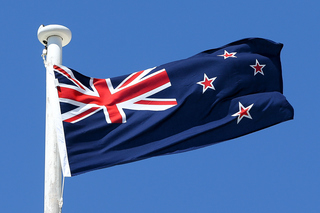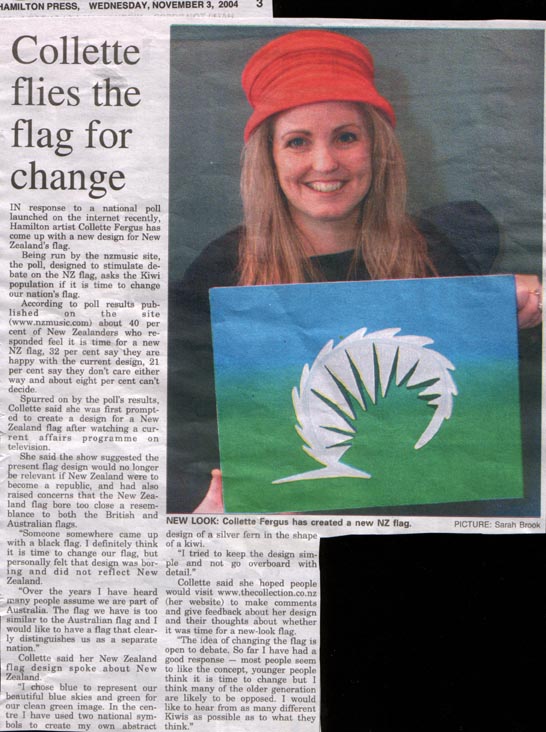The Debate over Changing the New Zealand Flag
Flag design is a fascinating field encompassing symbolism, history, culture, and national identity. In recent times it has often come up, and the debate surrounding flag changes has sparked discussions in various countries, including New Zealand. Many individuals argue for a new flag design, citing similarities between the New Zealand and Australian flags, as well as a desire to establish a unique representation of the country's identity, free from affiliations with the United Kingdom and the inclusion of the Union Jack.
Collette a New Zealand artist, a passionate advocate for flag design, entered the arena by proposing her tongue-in-cheek version of a new flag. She recognised that the discussion should go beyond a simple black design with a stylised silver fern, which had gained popularity. Although the Maori tino rangatiratanga flag is another alternative of which some elements should also be considered, it does not represent the diversity and culture of all New Zealanders.

Maori Tino Rangatiratanga Flag
Collette believed that it was necessary to think further outside the square and consider a range of design options that encompassed various aspects of New Zealand's identity.
Her unique design incorporated the vibrant imagery of a clean, green landscape with blue skies, which New Zealand or Aotearoa is known for. The flag featured a crisp, bright green blending into a rich blue, symbolising the country's lush environment and pristine natural beauty. In the centre, a silver fern was artfully shaped as a kiwi, representing New Zealand's iconic national symbol. Although Collette's design was intended to be more of a point-of-discussion idea aimed at capturing the essence of the country while embracing new and innovative elements. It was never meant to be considered a serious contender.
Collette's Flag Controversy
A local newspaper picked up on Collette's design and interviewed her, publishing an article accompanied by a photo showcasing her creation which you can see in the main image. However, the publication of Collette's design further fueled the controversy surrounding flag change discussions. Some readers misunderstood her intentions, presuming she was actively campaigning to change the flag and questioning her loyalty to its existing symbolism.
Fortunately, Collette had the opportunity to engage with individuals who held misconceptions about her design. She clarified that her intention was not to promote a specific flag change but to encourage open-mindedness and exploration of alternative design options. Collette's experience shed light on the potential for misunderstandings and the diverse interpretations that can arise from flag-related discussions.
Other Flags
In exploring flag design, it becomes evident that symbols hold significant meaning in various national flags. For instance, the cross on the flags of Greece, Scandinavian countries, and the British flag represent Christianity. Flags of Saudi Arabia and Iraq bear Islamic inscriptions, reflecting their religious affiliations. The Star of David on the flag of Israel signifies its ancient Jewish heritage.
Additionally, flags associated with communist ideologies often feature the hammer and sickle, as seen in the former Soviet Union (USSR) flag and the current flag of Angola. The colour red, often seen as a symbol of revolution and communism, is also prevalent in flags such as those of China and Vietnam.

The Union Jack's presence on New Zealand and Australian flags symbolises their historical ties and previous status as British colonies. However, the ongoing debate around flag design in these countries highlights a desire for a more distinct and independent representation.
Attaching flag design with a comprehensive understanding of history, symbolism, culture, and national identity is essential. By considering various factors and engaging in meaningful dialogue, a nation can work towards a flag authentically reflecting its values and aspirations. New Zealand artist Collette's involvement in the flag change discussions and the controversy surrounding it highlights the importance of exploring multiple design possibilities while fostering understanding and respect for diverse perspectives.
The flag design is a nuanced and multifaceted discipline, incorporating history, symbolism, culture, and national identity. It is essential to approach discussions and proposals with a comprehensive understanding of these factors. By carefully considering various aspects, exploring diverse design options, and engaging in meaningful dialogue, a nation can work towards a flag authentically reflecting its values and aspirations.
You can get moref information about different countries and their flags here at
Posted: Thursday 15 July 2010
